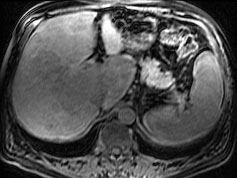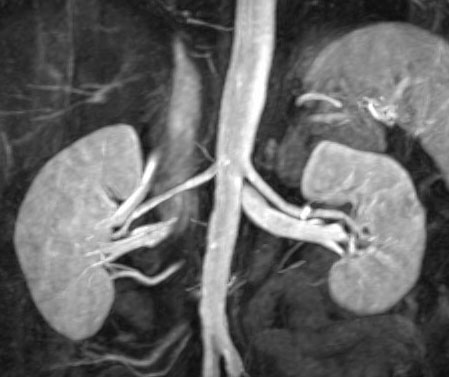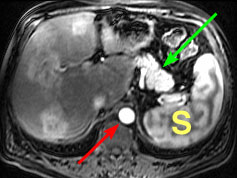Enhanced
Fast GRadient
Echo 3-Dimensional
(efgre3D)
or THRIVE
An optimized rapid 3-dimensional T1-weighted
technique. For body imaging and MRA, acquisitions often use half-Fourier (0.5
NEX) technique to minimize acquisition time, SPectral Inversion At Lipids
(SPECIAL, or SPIR) fat suppression is more effective and more efficient that
the fat saturation method used for other techniques. Zero-Fill Interpolation
involves inserting zeros in k-space; at TJUH it is used most commonly to produce
overlapping sections, also referred to as overcontiguous.
We use 3D spoiled gradient echo for all dynamic contrast
enhanced imaging in the body, including MRA, and use it as well for mangafodipir
(Teslascan)-enhanced studies. For imaging liver and other tissues, flip angle
should be about 15 degrees, to prevent oversaturation of tissues. For MRA,
saturation of tissues is desirable to reduce background, so flip angle should
be 40 degrees or more.
 |
 |
 |
|
|
Axial 3D images with SPECIAL fat suppression prior
to (top) and during the arterial post-contrast phase (bottom) in a patient
with metastases from colonic carcinoma. Signs of a successful arterial
phase include intense enhancement of aorta (red), pancreas (green) and
spleen (S).
|
Coronal Maximium Intensity Projection (MIP) image
using 3D spoiled gradient echo techique, with flip angle = 50 degrees,
higher than that used at left (15 degrees).
|
Copyright © Thomas Jefferson University. All Rights Reserved.
The Thomas Jefferson University web site, its contents and programs, is provided for informational and educational purposes only and is not intended as medical advice nor is it intended to create any physician-patient relationship. Please remember that this information should not substitute for a visit or a consultation with a health care provider. The views or opinions expressed in the resources provided do not necessarily reflect those of Thomas Jefferson University, Thomas Jefferson University Hospital, or the Jefferson Health System or staff.